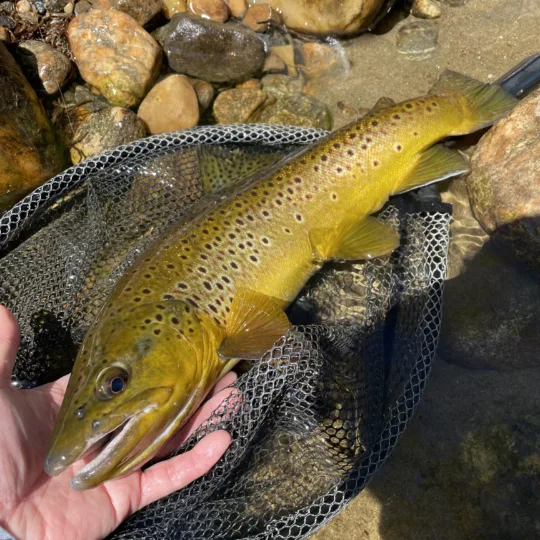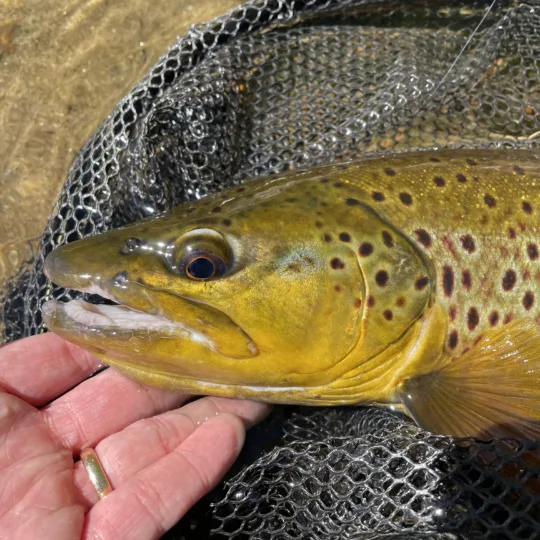After quite a few hours of casting with only one take to show for it (the fish rubbed me off on structure), I put down my rod and took off my chest pack. I sat on a rock and just watched the river’s endless gurgles and flows.
I was thinking of going home.
Some days, fly fishing is all work and no play. You hit the usual spots with your favorite flies, and nothing happens. Earlier this week, I was able to bunch up my meetings and fish during the work week. Plus, I’m in a holding pattern, as I await final exams to start grading.
The sun was up, the flows were great, and the water was nearly 60 °F. I anticipated fast action as I drove to the river.
I arrived at one of my favorite stretches and threw a big dry to see if I could mark fish. It’s a great technique that Jamie Carr taught me: you can see where the fish may be holding. I didn’t see any flashes or movements. Bugs were active. I saw caddis and various mayflies. I just couldn’t figure out a technique that would work. I threw: dries and then dry-droppers on my dry-fly rod and then tightlined, rotating flies repeatedly. No grabs.
Then, a thought hit me: “Don’t go home, as some of your biggest fish appeared after you nearly gave up.” It’s true. I don’t know what it is, but most of my memorable fish showed themselves on slow days and just after I resolved to stay after debating whether to leave. Still, I didn’t know what to do.
So, I decided to practice my dry-fly casting. I had brought with me my Orvis H2 four-weight, still rigged up from last summer’s Montana trip with 6x. I targeted a slow seam next to a riffle and gradually increased my casts: 20 feet, 30 feet, 40 feet, etc. I’m not a great dry-fly caster, but I’m trying to get better.
Below a rock, suddenly, a huge head appeared and engulfed my dry after a very long cast. Miraculously, I waited the right amount of time before setting the hook Goldilocks-style, neither too soft or too hard, given the 6x tippet.
Whatever fish it was immediately took off for the other side of the river. I pointed the rod tip into the water and applied side pressure, gradually gaining line as the fish tired from its first sprint. This happened three more times. Eventually, I saw a large brown and was incredibly relieved when it slid into the net. Truly, a Mr. Big.
I couldn’t believe how large and beautiful it was: pectoral fins like paddles, a perfect dorsal fin, broad shoulders, blue cheeks, and feisty. The pictures don’t do justice to the colors on the fish. Even better, the dry fly was stuck perfectly in the right-hand corner of its mouth. It taped at 20″ exactly, and I measured it twice to make sure.

With tightlining, you can see some big fish, and I’ve seen a few. I’ve caught some nice steelhead, again, while Euronymphing. But, I don’t think I’ve ever caught a fish so large nor that beautiful on a dry fly. I just couldn’t believe it.
I fished a few more hours, but I wasn’t too stressed. I only landed three fish total for a full day’s of work, but that brown was worth the drive and dozens of them. I don’t know if I’ll see anything that pretty again from a dry.
Plus, here’s to luck. I’m not a great dry-fly angler. And, I caught that fish while practicing my casting. But, I’m down with a fish that was 90% luck.
During the drive home, I chatted with Jamie. I also stopped for a snack. It’s hard to turn down a Deluxe McCrispy at the Golden Arches when the app gives you a 25% discount (and photograph it in Portrait Mode for laughs and effect).

I’m not sure it matters, but the fish took a cripple I tied. The fly recipe is below. I almost never fish dun patterns and rely on emergers, parachutes, and cripples for the most part.
The cripple pattern is amazing. On a very slow day at the famed DePuy spring creek in Montana, for example, nothing happened until I put on a size 20 cripple.
Here’s what I did for a Sulphur Cripple:
-
- Hook: size 16 barbless dry-fly hook
- Shuck: brown Antron
- Body: brown thread, tied thin
- Wing: light elk hair
- Hackle: brown
- Thorax: Superfine dubbing in PMD yellow
Tight lines! We are just starting to enter the glory weeks for New England fly fishing.
Discover more from BlogFlyFish.com
Subscribe to get the latest posts sent to your email.




Very nice fish and sometimes persistence pays off! Just curious did you see Sulfur’s hatching or just prospecting? My best two prospecting dry’s are an Adams Parachute, and especially an Ausable Bomber in summer.
BTW, I tied up a Golden Retriever pattern written up on one of your older posts, and had a blast jigging it on the Farmington in MA. Tons of caddis hatching and Quill Gordon Spinners dancing around and not a rise! The difference between the freestone in MA and tailwater in CT I guess.
Thanks! I did see a few Sulphurs but was prospecting. Saw only a handful of rises all day.
Yes, that pattern is Joel Watson’s!
Steve, I think I was wrong. I probably saw Vitreus.
The hanging emerger is deadly. Especially on very picky fish. I was fishing a Hendrickson hatch n the Farmington in Connecticut many seasons ago. Despite the big duns coming down the run, there was a persistent, subtle rise against the far bank, but the Hendrickson duns were being ignored. I put on a small, maybe #16 hanging emerger I’d bought on a Montana trip.- deer hair tuft at a 45 degree angle from the hook, above a collar of hackle – gray absorbent dubbing underneath. First good float, it was sipped in. An honest eighteen inch holdover brown. A very satisfying fly choice.
Nice!